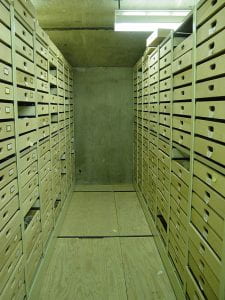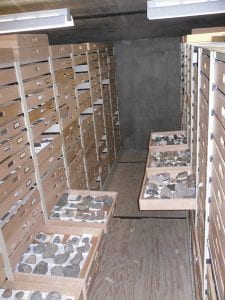 The Thomas A. Greene Collection contains over 75,000 geological specimens, largely collected by Greene between 1880 and his death in 1894. The vast majority of this collection was hand-selected from small, manually quarried deposits of Silurian and Devonian Period fossil beds located in southeastern Wisconsin and northeastern Illinois. Today’s mechanized and fully-automated quarrying techniques make it all but impossible for any such comparable collection to ever be assembled again. These circumstances make the Greene Collection an unparalleled source for paleontological research the world over.
The Thomas A. Greene Collection contains over 75,000 geological specimens, largely collected by Greene between 1880 and his death in 1894. The vast majority of this collection was hand-selected from small, manually quarried deposits of Silurian and Devonian Period fossil beds located in southeastern Wisconsin and northeastern Illinois. Today’s mechanized and fully-automated quarrying techniques make it all but impossible for any such comparable collection to ever be assembled again. These circumstances make the Greene Collection an unparalleled source for paleontological research the world over.
For much of its history, this world-class collection of fossils primarily from the Ordovician, Silurian, and Devonian Periods has been largely inaccessible to the scientific community for want of a proper catalog. In 2017, Dr. Stephen Dornbos (UWM) in coordination with Patricia Coorough-Burke (Milwaukee Public Museum) and Paul Mayer (Field Museum of Natural History) applied for, and secured a grant from the Institute of Museum and Library Services (IMLS) to begin digitizing the Thomas A. Greene Collection.
 Working alongside collection manager Scott Schaefer (UWM) a team of student interns have begun to diligently tag, photograph, and catalog the massive collection. As of Spring 2020, over 20,000 fossil specimen records have been entered into the catalog with the next phase focusing heavily on generating high resolution images of the most significant specimens in the collection.
Working alongside collection manager Scott Schaefer (UWM) a team of student interns have begun to diligently tag, photograph, and catalog the massive collection. As of Spring 2020, over 20,000 fossil specimen records have been entered into the catalog with the next phase focusing heavily on generating high resolution images of the most significant specimens in the collection.
 Upon completion of this initial digitization campaign, data and images will be made accessible to the scientific community and the public via the iDigBio Portal (link here: https://www.idigbio.org/). In an era of ever-growing online data access, a newly digitized Thomas A. Greene Collection will finally bring these amazing specimens out from their humble and quiet storage room here at UWM and into the light of scientific study and discovery once again. Soon students of all ages, and walks of life, here and abroad will have access to look upon the thousands of beautiful specimens with the same admiration and wonderment as the collection’s namesake, Thomas A. Green had done nearly a century and a half earlier.
Upon completion of this initial digitization campaign, data and images will be made accessible to the scientific community and the public via the iDigBio Portal (link here: https://www.idigbio.org/). In an era of ever-growing online data access, a newly digitized Thomas A. Greene Collection will finally bring these amazing specimens out from their humble and quiet storage room here at UWM and into the light of scientific study and discovery once again. Soon students of all ages, and walks of life, here and abroad will have access to look upon the thousands of beautiful specimens with the same admiration and wonderment as the collection’s namesake, Thomas A. Green had done nearly a century and a half earlier.